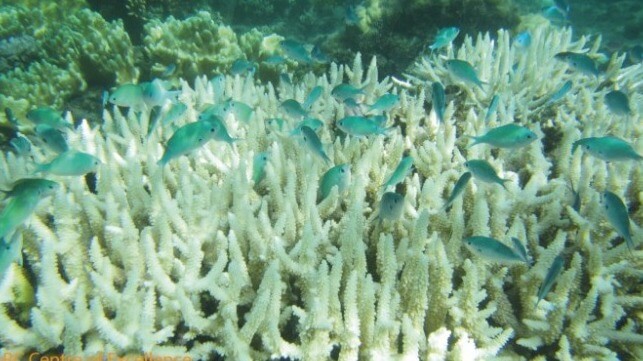Extreme Heat Causes Mass Bleaching Event at Great Barrier Reef

[By Terry Hughes]
For the fifth time in just the past eight summers – 2016, 2017, 2020, 2022 and now 2024 - huge swathes of the Great Barrier Reef are experiencing extreme heat stress that has triggered yet another episode of mass coral bleaching.
Including two earlier heating episodes – in 1998 (which was at the time the hottest year globally on record) and 2002 – this brings the tally to seven such extreme events in the past 26 years.
The most conspicuous impact of unusually high temperatures on tropical and subtropical reefs is wide-scale coral bleaching and death. Sharp spikes in temperature can destroy coral tissue directly even before bleaching unfolds. Consequently, if temperatures exceed 2°C above the normal summer maximum, heat-sensitive corals die very quickly.
What is coral bleaching?
Bleaching happens when marine heatwaves disrupt the relationship between corals and their “photosynthetic symbionts” – tiny organisms that live inside the corals’ tissues and help power their metabolism.
Severe bleaching is often fatal, whereas corals that are mildly bleached can slowly regain their symbionts and normal color after the end of summer, and survive.
Before 1998, coral bleaching on the Great Barrier Reef was infrequent and localized. But over the past four decades, bleaching has increased in frequency, severity and spatial scale, as a result of human-induced climate heating.
“Mass coral bleaching” refers to bleaching that is severe and widespread, affecting reefs at a regional scale or even throughout the tropics triggered by rising global sea temperatures.
The Great Barrier Reef consists of more than 3,000 individual coral reefs. It’s the same size as Japan or Italy, and extends for 2,300 kilometers along the coast of Queensland. Widespread coral deaths during extreme heatwaves, affecting hundreds of millions of coral colonies, far exceed the damage typically caused by a severe cyclone.
How bad is 2024?
Heat stress this week is reaching record levels on large parts of the Great Barrier Reef.
Climate scientists can measure the accumulation of heat stress throughout the summer by using a metric called “degree heating weeks” (DHW), which factors in both the duration and intensity of extreme heat exposure. This measures how far the temperature is above the threshold that triggers mild bleaching (1°C hotter than the normal summer maximum), and how long it stays above that threshold.
The same DHW exposure can result either from a long, moderate heatwave or from a short, intense peak in temperatures. The 2023–24 summer has been a slow burner on the Great Barrier Reef – sea temperatures have not been as extreme as during previous bleaching events, but they have persisted for longer.
As a general rule of thumb, 2–4 DHW units can trigger the onset of bleaching, and heat-sensitive species of coral begin to die at 6–8 DHW units. So far this summer, according to the US National Oceanographic and Atmospheric Administration, heat stress on the Great Barrier Reef has climbed to 10–12 DHW units on many individual reefs, and has been north and south compared to the central region. Heat stress will likely peak in the next week or two at levels above all previous mass bleaching and mortality events since 1998, before falling as temperatures drop.
Coral bleaching is typically very patchy at the enormous scale of the Great Barrier Reef. In each of the previous events since 1998, 20–55% of individual reefs experienced severe bleaching and coral deaths, whereas 14–48% of reefs were unharmed.
Given the near-record levels of heat stress this summer, we can expect heavy losses of corals to occur on hundreds of individual reefs over the next few months.
What’s the longer-term outlook?
This latest, still-unfolding event was entirely predictable, as ocean temperatures continue to rise due to global heating.
Three of the seven mass bleaching events so far on the Great Barrier Reef coincided with El Niño conditions (1998, 2016 and this summer), and the remaining four did not. Increasingly, climate-driven coral bleaching and death is happening regardless of whether we are in an El Niño or La Niña phase. Average tropical sea surface temperatures are already warmer today under La Niña conditions than they were during El Niño events only three or four decades ago.
The Great Barrier Reef is now a checkerboard of reefs with different recent histories of coral bleaching. Reefs that bleached in 2017 or 2016 have had only five or six years to recover before being hit again this summer – assuming they escaped bleaching during the 2020 and 2022 episodes.
Clearly, the gap between consecutive heat extremes is shrinking – we are vanishingly unlikely to see another 14-year reprieve like 2002 to 2016 again in our lifetimes, until global temperatures stabilize.
Ironically, the corals that are now prevalent on many reefs are young colonies of fast-growing, heat-sensitive species of branching and table-shaped corals – analogous to the rapid recovery of flammable grasses after a forest fire. These species can restore coral cover quickly, but they also make the Great Barrier Reef more vulnerable to future heatwaves.
Attempts to restore depleted coral cover through coral gardening, assisted migration (by harvesting larvae) and assisted evolution (rearing corals in an aquarium) are prohibitively expensive and unworkable at any meaningful scale. In Florida, coral nurseries suffered mass deaths due to record sea temperatures last summer.
The only long-term way to protect corals on the Great Barrier Reef and elsewhere is to rapidly reduce global greenhouse emissions.
Terry Hughes is a Distinguished Professor at James Cook University.
This article appears courtesy of The Conversation and may be found in its original form here.

The opinions expressed herein are the author's and not necessarily those of The Maritime Executive.
